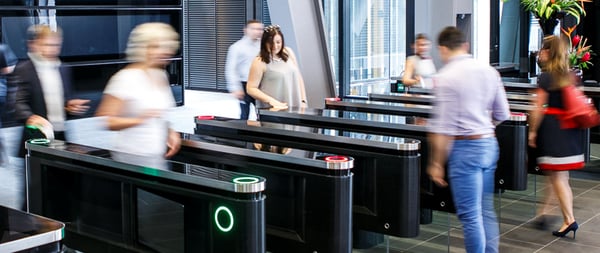It’s the third installment of our S.T.A.R.T.S.S. blog series! This unique decision methodology provides a framework for selecting the best security entrance and provider. Click here to learn more by reading the S.T.A.R.T.S.S. series introduction.
Today we’re discussing: Throughput.
The C-suite approves security entrances because they are an effective way to manage risks, ensure safety and security, secure physical and data assets, and prevent liability issues. It’s up to you to make a solid decision as to the type of security entrance product to choose, install and maintain to ensure a solid ROI. But once that selection is made, you have another decision that could make or break your project: what’s the right number of entrances necessary to handle your traffic needs? And how do you calculate that?
Consider the Building When Calculating Throughput
 One of the biggest mistakes security professionals can make is not installing enough entrances to accommodate their throughput needs, which is the number of people moving in and out of their building. Throughput affects users directly on a daily basis, so it’s critical to get it right.
One of the biggest mistakes security professionals can make is not installing enough entrances to accommodate their throughput needs, which is the number of people moving in and out of their building. Throughput affects users directly on a daily basis, so it’s critical to get it right.
To calculate throughput, you must consider current and maximum building occupancy levels, employee workflows, elevator banks and waiting area capacities. The directional use of any installed turnstile or door can change during the course of a normal workday. For example, during morning rush hours, there should be more in-bound lanes open, and during the afternoon rush hours, it should be the other way around. Other factors to consider include whether you need one-way or two-way traffic, and where will you provide access for the disabled or individuals transporting large items.
What Does the Manufacturer Say?
Next, you’ll need to note the throughput numbers the manufacturer declares for the types of turnstiles or security doors you are considering. Usually, this is published as a range of users per minute, for example 25-30 people per minute. If a manufacturer publishes numbers above 35 people per minute, ask them how those numbers were calculated, as most trained users tend to take 2 to 3 seconds to swipe a badge or present their identity to a biometric device and move on through. Ask if a given security entrance allows for card stacking (multiple people authorizing and then proceeding through an entrance in sequence without waiting for turnstile barriers to close and then open again). This can save quite a bit of time during a busy morning rush hour.
Counting is An Ideal Way to Estimate
If you have an existing building full or people, you’re in luck because there is less guesswork. Simply count – manually! – the number of people coming in and leaving during the busiest period of the day. Don’t rely on access control data, which may miss people who are tailgating behind authorized users.
Next, during the busiest lunch hours, count the number of people coming and going through the entryway. You’ll need this number when considering whether to get entrances that are bi-directional (handle two-way traffic). Most turnstiles require people to wait and take turns (people tend to slow down in this scenario), while a security revolving door can handle two flows simultaneously. Once you have your counted numbers, be sure to discuss these with your security consultant or entrance manufacturer. It is also prudent to never have just one entrance for a given location as it will likely experience downtime in the future for maintenance.

Why It’s Important to Get Throughput Right
If you miscalculate throughput you could cause pileups during rush periods that can trigger complaints and undermine your credibility. Too many turnstiles mean wasted financial and space resources. Too few lanes can mean lost time, lower productivity and frustrated users that are calling you or your C-Suite to complain.
Want to learn more about calculating throughput? Click here to download our essential guide.
Stay tuned for Topic #3: Aesthetics.
If you have questions about S.T.A.R.T.S.S. or properly determining how many entrances you need to accommodate your traffic, please contact us directly.
